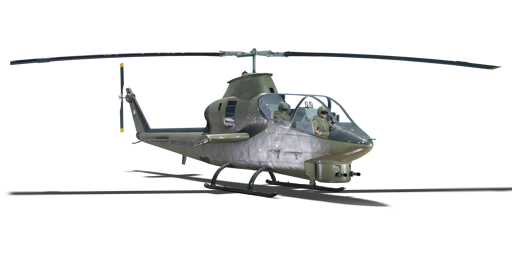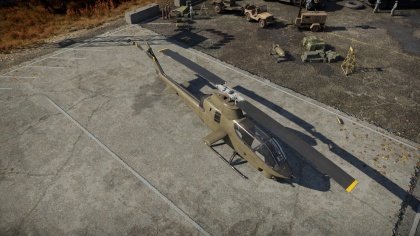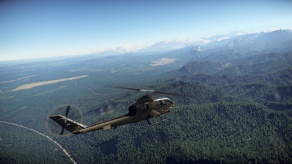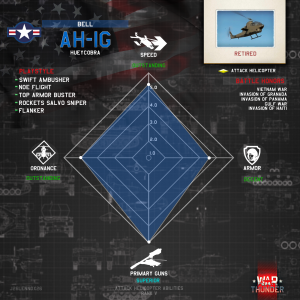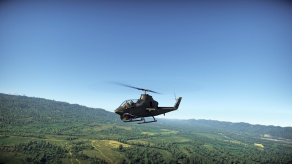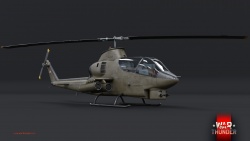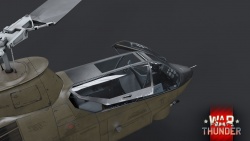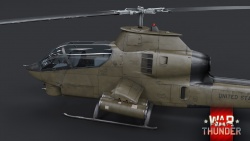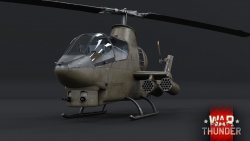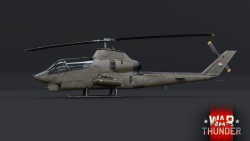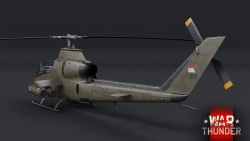Difference between revisions of "AH-1G"
TiMe_tO_FaiL (talk | contribs) m (→Flight performance) (Tag: Visual edit) |
m (Radar stat ADDED) (Tag: Visual edit) |
||
| Line 81: | Line 81: | ||
<!--Describe the tactics of playing in the helicopter, the features of using vehicles in a team and advice on tactics. Refrain from creating a "guide" - do not impose a single point of view but give the reader food for thought. Examine the most dangerous enemies and give recommendations on fighting them. If necessary, note the specifics of the game in different modes (AB, RB, SB).--> | <!--Describe the tactics of playing in the helicopter, the features of using vehicles in a team and advice on tactics. Refrain from creating a "guide" - do not impose a single point of view but give the reader food for thought. Examine the most dangerous enemies and give recommendations on fighting them. If necessary, note the specifics of the game in different modes (AB, RB, SB).--> | ||
[[File:AH-1G Test fly.jpg|thumb|292x292px|A brief test fly screenshot]] | [[File:AH-1G Test fly.jpg|thumb|292x292px|A brief test fly screenshot]] | ||
| − | |||
In helicopter battles, the AH-1G serves best in an anti-air role by combating other enemy helicopters. Due to being the only dedicated attack helicopter for the first half of the USA helicopter tree, it serves as the backbone for eliminating enemy air threats for US pilots until the AH-1F and AH-1Z become researchable. | In helicopter battles, the AH-1G serves best in an anti-air role by combating other enemy helicopters. Due to being the only dedicated attack helicopter for the first half of the USA helicopter tree, it serves as the backbone for eliminating enemy air threats for US pilots until the AH-1F and AH-1Z become researchable. | ||
| Line 89: | Line 88: | ||
=== Pros and cons === | === Pros and cons === | ||
| − | <!--Summarize and briefly evaluate the vehicle in terms of its characteristics and combat effectiveness. Mark its pros and cons in the bulleted list. Try not to use more than 6 points for each of the characteristics. Avoid using categorical definitions such as "bad", "good" and the like - they have a substitution in the form of softer "inadequate", "effective".--> | + | [[File:CHARTWTTEMPLATE9.png|thumb|Attack helicopter abilities of the Cobra AH-1G.]]<!--Summarize and briefly evaluate the vehicle in terms of its characteristics and combat effectiveness. Mark its pros and cons in the bulleted list. Try not to use more than 6 points for each of the characteristics. Avoid using categorical definitions such as "bad", "good" and the like - they have a substitution in the form of softer "inadequate", "effective".--> |
'''Pros:''' | '''Pros:''' | ||
| Line 111: | Line 110: | ||
== History == | == History == | ||
<!--''Describe the history of the creation and combat usage of the helicopter in more detail than in the introduction. If the historical reference turns out to be too big, take it to a separate article, taking a link to an article about the vehicle and adding a block "/ History" (example: <nowiki>https://wiki.warthunder.com/(Vehicle-name)/History</nowiki>) and add a link to it here using the <code>main</code> template. Be sure to reference text and sources by using <code><nowiki><ref></nowiki></code>, as well as adding them at the end of the article.''--> | <!--''Describe the history of the creation and combat usage of the helicopter in more detail than in the introduction. If the historical reference turns out to be too big, take it to a separate article, taking a link to an article about the vehicle and adding a block "/ History" (example: <nowiki>https://wiki.warthunder.com/(Vehicle-name)/History</nowiki>) and add a link to it here using the <code>main</code> template. Be sure to reference text and sources by using <code><nowiki><ref></nowiki></code>, as well as adding them at the end of the article.''--> | ||
| + | [[File:AH-1G .jpg|alt=Brief test fly screenshot.|thumb|292x292px]] | ||
Parallel to the development of the UH-1 transport helicopter, Bell was actively conducting research on helicopter gunship designs. This resulted in the creation of the Model D255 “Iroquois Warrior”, a mockup of a gunship design based on components from the UH-1B Huey. The mockup was presented to interested Army officials in June 1962, resulting in a proof-of-concept contract later that year. Following the contract award, Bell created the Model 207 “Sioux Scout”, which was evaluated by the Army in early 1964. | Parallel to the development of the UH-1 transport helicopter, Bell was actively conducting research on helicopter gunship designs. This resulted in the creation of the Model D255 “Iroquois Warrior”, a mockup of a gunship design based on components from the UH-1B Huey. The mockup was presented to interested Army officials in June 1962, resulting in a proof-of-concept contract later that year. Following the contract award, Bell created the Model 207 “Sioux Scout”, which was evaluated by the Army in early 1964. | ||
Revision as of 21:39, 13 October 2020
Contents
| This page is about the aircraft AH-1G. For other uses, see AH-1 (Family). |
Description
The AH-1G is a Rank V USA attack helicopter
with a battle rating of 8.7 (AB) and 8.0 (RB/SB). This helicopter was introduced in Update 1.81 "The Valkyries".
This helicopter, being the first Attack Helicopter in the American Tech Tree, is a maneuverable and powerful beast if used in the right hands. It has 7 armaments presets, most of which need to be researched. The AH-1G comes with one secondary weapon, in the form of 28 Mighty Mouse rockets.
General info
Flight performance
Despite having not the best flight performance of helicopters, it is still better than most counterparts. It can struggle to get off the ground, and the collective cannot be increased to 100% without causing a severe decrease in engine RPM. It is maneuverable at low and medium speed, and can get up to 255 km/h in a straight line at low level.
| Characteristics | |||
|---|---|---|---|
| Stock | |||
| Max Speed (km/h at 1,000 m) |
Max altitude (meters) | ||
| AB | RB | ||
| 261 | 255 | 3475 | |
| Upgraded | |||
| Max Speed (km/h at 1,000 m) |
Max altitude (meters) | ||
| AB | RB | ||
| ? | ? | 3475 | |
Survivability and armour
- 12 mm steel - engine
- 20 mm composite boron-carbide - pilot/gunner seats
- Self-sealing fuel tanks: 2 in central fuselage
The AH-1G is by no means the most survivable helicopter, with relatively weak armor and fuel tanks that are prone to catching on fire. However, if the helicopter removes the threat of AA before dealing with other targets and stays out if range of small tank mounted machine guns, it is very effective. When fighting the AH-1G, it is always a good bet to get the "High Ground" or altitude advantage of this vehicle. Try to strafe it and get around to its blinds spot, as it can't use the tail rotor effectively when moving. Always aim for the cockpit, as one the gunner is knocked out the turret becomes unusable. When coming up against a Cobra with gun pods, or and secondary weapons, know that the pilot can still fire these even if the Gunner in knocked out.
Armaments
Offensive armament
The AH-1G can carry up to 4 x 7.62 mm miniguns with a very generous ammo supply allowing it to put out an extremely dense amount of fire over an extended period. This should be used to the pilot's advantage when engaging enemy aircraft in the skies.
The standard armament of the AH-1G can be switched for a dual 40mm M129 grenade launcher (can be researched as a tier III modification). This is an excellent CQB weapon, and has much better penetration then the miniguns. However, the range is very short, it can't be used against aircraft, and it can be tricky to aim.
Suspended armament
- 28 x FFAR Mighty Mouse rockets
- 76 x FFAR Mighty Mouse rockets
- 2 x 7.62 mm M134 Minigun machine gun (3,000 rpg)
- 1 x 20 mm M195 cannon (1,500 rpg)
- 2 x 7.62 mm M134 Minigun machine gun (3,000 rpg) + 14 x FFAR Mighty Mouse rockets
- 2 x 7.62 mm M134 Minigun machine gun (3,000 rpg) + 38 x FFAR Mighty Mouse rockets
Unlike other AH series helicopters, the AH-1G can equip either two 7.62 mm Miniguns or one 20 mm Gatling gun as suspended armaments. The minigun can pack a real punch when engaging enemy helicopters due to their light armour, however, the one drawback will be the pilot will have to deal with the massive recoil from the fast rate of fire.
The AH-1G can also serve in a ground pounding role by equipping FFAR rockets that can reload quite quickly while still being able to defend itself with its turret miniguns. While the AH1G cannot carry as much ordinance as its Soviet counterparts, it can defend itself very well and even equip suspended armament such as rockets, something which the Soviet choppers cannot do until BR 9.7.
Usage in battles
In helicopter battles, the AH-1G serves best in an anti-air role by combating other enemy helicopters. Due to being the only dedicated attack helicopter for the first half of the USA helicopter tree, it serves as the backbone for eliminating enemy air threats for US pilots until the AH-1F and AH-1Z become researchable.
The AH-1G is sluggish when it comes to climbing rate. This results in the vehicle being very maneuverable at low altitudes. Players should always save rockets for enemy vehicles that need it.
In-ground realistic battle, the AH-1G has the best loadout for 8.0 helicopter. The twin 40 mm grenade launcher is the best for dealing with tanks at a close range battle but should be very careful of any tanks or SPAA.
Pros and cons
Pros:
- Two miniguns have a very high rate of fire
- Fairly small target due to its small width dimension
- Can equip several Hydra rocket pods, miniguns, and cannon as payload
- Miniguns do not jam unlike conventional guns
- Twin 40mm grenade launchers are very effective against a tank, even at high ranks
- Has the best CAS capability for a starting helicopter
Cons:
- Limited traverse for the miniguns
- Does not have any guided munitions
- The 20 mm cannon gun pod has a lot of recoil which can throw your aim off
- 40mm grenade has a slow travel speed, the pilot has to aim away from the enemy to hit
- Slow climb rate if using a heavy payload
- Stock 7.62mm minigun is insufficent against anything other than helicopters
History
Parallel to the development of the UH-1 transport helicopter, Bell was actively conducting research on helicopter gunship designs. This resulted in the creation of the Model D255 “Iroquois Warrior”, a mockup of a gunship design based on components from the UH-1B Huey. The mockup was presented to interested Army officials in June 1962, resulting in a proof-of-concept contract later that year. Following the contract award, Bell created the Model 207 “Sioux Scout”, which was evaluated by the Army in early 1964.
Although impressed by the Model 207, the Army sought a larger and more powerful design, resulting in the creation of a new competition (AAFSS Advanced Aerial Fire Support System), of which Bell was not a part of. Instead, Bell independently continued developing and refining their gunship design, eventually creating the Model 209 - a design that was a combination of the Iroquois Warrior mockup and the concepts behind the Model 207.
Meanwhile, the ongoing Vietnam War sparked an urgent demand for dedicated attack helicopters. Although gunship versions of the UH-1 performed this role with relative success, the fact that they weren’t initially intended for this role somewhat limited their effectiveness. Back in the States, the Army’s ongoing competition produced no winning design as a result of technical and political difficulties. To quickly address their demand, the Army started looking for an interim design to act as a stopgap measure in 1965.
Soon after testing of the Model 209 concluded in September 1965, the Army decided to award Bell with a manufacturing contract later that year. The contract officially put the Model 209 into production under the Army designation of UH-1H Huey Cobra but was later redesignated to AH-1G Cobra.
The AH-1G Cobra entered service with the U.S. Army in 1967, participating mainly through the remainder of the Vietnam War as well as other conflicts. The AH-1G was retired from active service in the early 1980s, being replaced by newer models of the Cobra. The AH-1G also served with the Spanish Navy 1971 - 1985. And with the Israeli Armed forces from 1974 -1977.
- From Devblog
Media
- Images
- Videos
See also
- Related development
- Aircraft of comparable role, configuration and era
- Agusta A129 Mangusta
External links
| Bell Aircraft Corporation | |
|---|---|
| Aircraft | |
| Fighters | P-39N-0 · P-39Q-5 |
| P-400 | |
| P-63A-10 · P-63A-5 · P-63C-5 · ␠Kingcobra | |
| Jet Fighters | P-59A |
| Export | ▂P-39K-1 · ▂Pokryshkin's P-39N-0 · ▂P-39Q-15 · ▄P-39Q-25 |
| ▂P-63A-5 · ▂P-63A-10 · ▂P-63C-5 · ▄P-63C-5 | |
| Helicopters | |
| Attack | AH-1F · AH-1G · AH-1Z · AH-1W |
| OH-58D | |
| Utility | UH-1B · UH-1C · UH-1C XM-30 |
| Export/Licensed | ▅UH-1B · ◄UH-1D |
| Tzefa A · Tzefa B · Tzefa D/E · ▅AH-1S early · ▅AH-1S · ▅AH-1S Kisarazu · ␗AH-1W | |
| ␗OH-58D | |
| See Also | Fuji Heavy Industries · Agusta |
| USA helicopters | |
|---|---|
| Attack | |
| Black Hawk | MH-60L DAP |
| Choctaw | H-34 |
| Cobra | AH-1F · AH-1G · AH-1Z |
| SuperCobra | AH-1W |
| Kiowa | OH-58D |
| Little Bird | AH-6M |
| Apache | YAH-64 · AH-64A · ▃AH-64A Peten · AH-64A (GR) · AH-64D |
| Utility | |
| Huey | UH-1B · UH-1C · UH-1C XM-30 |


